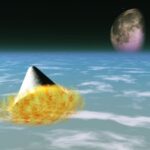Today, I want to share with you three “Life on Earth” stories that intrigued me.
- The Silurian Hypothesis
- Changes to the geomagnetic field linked to atmospheric oxygenation events
- Evolutionary fast tracking called autopolyploidy
The Silurian Hypothesis

A friend of mine sent me a recent article describing the Silurian Hypothesis. This theory was first proposed by Adam Frank and Gavin Schmidt, the former an astrophysicist, the latter a climate scientist.
Frank and Schmidt described the conveyor belt of plate tectonics and erosion as wiping out evidence from Earth’s past. They noted that most of the Earth’s crust is recycled every 170 million years. The few exceptions are places like the Canadian Shield. They also described why the fossil record is incomplete because conditions for fossilization are rare, with only a tiny percentage of animals and plants leaving evidence of their existence in rocks.
Frank and Schmidt posed the Silurian Hypothesis, noting that if finding life from the past is so difficult, imagine trying to find evidence of past civilizations that might have existed and vanished hundreds of millions of years ago.
A civilization that existed millions of years ago wouldn’t be like the archaeological discoveries that are merely a few thousand years old. When the Spanish conquered Central and South America, vanquishing the Aztec and Inca Empires, they were unaware of the prior existence of a Mayan civilization. When Europeans first crossed the Appalachian Mountains in the 17th century, they described a wilderness of forests and grasslands where a century earlier, Indigenous villages thrived. The evidence for their existence was almost missed.
Frank and Schmidt noted that the evidence for our existence in a geological period now named the Anthropocene would largely exist as artifacts in cities, which occupy a mere 1% of the planet’s surface. A geologist of the future would likely never find these artifacts. Our existence might be discovered from the presence of plastics found within sandstone and limestone sedimentary rocks. Frank and Schmidt also suggest that nuclear waste residue and long-term chemical traces could be found by geologists of the future to indicate our existence in the past. However, the crustal conveyor belt would only give future geologists a relatively small window of time to discover if that civilization existed nearly 170 million years in the past.
Neither scientist claims such a past civilization existed. The purpose of the Silurian Hypothesis, they state, is to show how difficult it is to find evidence of a technologically advanced civilization after a few million years.
Atmospheric Oxygenation And Earth’s Magnetic Field

Could past changes to Earth’s magnetic field be connected to oxygenation events from Earth’s past? Benjamin Mills is a biogeochemist at the University of Leeds and a co-author of a study published this month in the journal Science Advances that has compiled a record for the last 540 million years indicating a strong relationship between oxygen levels in the atmosphere and changes to the planet’s magnetic field.
The earliest evidence of life on Earth can be found in the geological record dating back 3.5 billion years. Was life only possible within the shield of our planet’s magnetic field, and when changes to it occurred, could that impact life?
Earth’s magnetic field has fluctuated throughout the planet’s past. Generated by convection currents in the liquid core that interact with the planet’s natural rotation, the magnetic field is a natural dynamo.
Currents within the molten iron and nickel core, however, vary over time, which causes changes to where the magnetic north and south poles are, and can even produce polarity reversals. We can see a record of the magnetic field changes in the alignment of crystals in magnetized volcanic rocks produced throughout Earth’s history.
The magnetic field is credited with shielding our atmosphere from the solar wind and cosmic rays, which have played havoc with the atmosphere of Mars, where its weaker and uneven magnetic field led to the planet losing most of its atmosphere over time.
The study was able to deduce historic oxygen levels from the chemical content of rocks and minerals at the time of their formation. It then compared that to the pattern of changes in magnetized rocks over similar periods. It turned out the two data sets aligned with changes to the magnetic field correlating with rising and falling patterns of oxygen in the atmosphere going back to the Cambrian Explosion, the moment when complex life on Earth first emerged.
So far, the research from the Cambrian to the present shows an alignment between magnetic field changes and atmospheric oxygen levels. Further research will look at correlations that stretch further back in time as well as the dynamics of other atmospheric gases, particularly nitrogen, to see if it is equally affected by magnetic field changes.
Autopolyploidy: The Key To Rapid Evolution

A paper recently published in the journal The American Naturalist describes how plants that are defined as autopolyploid can create genetic diversity in an instant. One of the plants that can do this is the Beetleweed, commonly found in the Appalachian Mountain region of the United States. You can see Beetleweed in the above picture.
In the absence of others of its kind, an autopolyploid can reproduce, creating an extra copy of its DNA and two identical sets of chromosomes. These plants can, therefore, perpetuate a species without sex. In reproductive isolation, they can become the dominant version within an ecosystem. Any chromosomal variation caused by external influences instantly becomes a common trait for the entire autopolyploid plant community.
Imagine a sudden environmental collapse that wipes out entire species of plants. In the absence of other fellow plant species, this ability to generate a double set of DNA ensures survival and rapid population recovery.
Autopolyploids can quickly differentiate as mutations breed true within descendants. Within a local area that started with a single autopolyploid plant, it can beget a diverse population that appears to be more responsive to environmental stresses than diploid plants that require two to tango. It turns out that where autopolyploidy predominates, the plant offspring show improved tolerance to environmental stress such as drought, saline soils, and temperature extremes.









